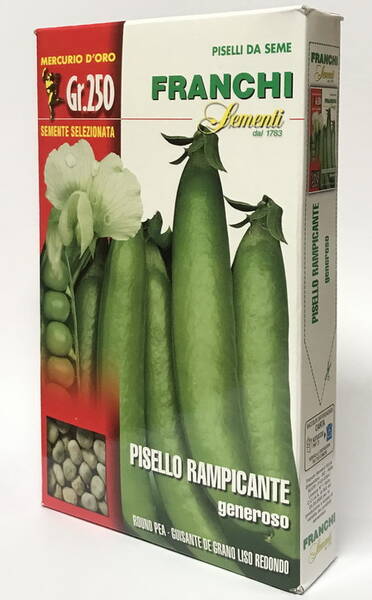Early-maturing, climbing, tall variety (110-120 cm). From germination to technical maturity 50-60 days.
The pod is large, arcuate and pointed, containing 8-9 smooth peas. Excellent taste.
The variety is resistant to the main pea diseases.
* For consumption, only completely green, but already sufficiently filled pods are picked (it should be noted that peas have a weak root system, therefore, when picking pods, it is necessary to hold the stem with one hand so that the plant is not accidentally pulled out of the soil by the pod).
In terms of ripening time, peas can be early-maturing (about 55 days from the moment of germination), mid-early (approximately 65 days), mid-late (from 75 to 85 days) and late-maturing (90-100 days). In order to enjoy young green peas throughout the summer, it is necessary to sow several varieties with different ripening times at the same time. Or you can sow peas in several stages, that is, with an interval of 10 days.
Sowing of all types of peas can be done quite early, since they are all cold-resistant. Pea grains do not need preliminary soaking; they are sown dry to a depth of 5 cm in moist soil and covered with film.
After 10-15 days, seedlings begin to appear (at this moment, the film must be removed immediately so that they do not "burn").
Supports for peas are recommended to be installed immediately before sowing to scare away birds that can cause significant damage to young plants.
Plants need to be tied to a trellis when they reach a height of 15-20 cm. However, there are low-growing varieties (for example, belonging to the "Afila" varietal type) that do not require tying, especially if two grains are sown together. As a result, the plants will cling to each other, which will prevent them from falling to the ground (but remember that low-growing varieties are less productive).
When the first buds appear, pea moth (pea weevil) can attack the peas. It punctures the bud and then lays a larva in it. To prevent this, you need to spray the plants with "Fitoferm" or another systemic acaricide. Since the pest parasitizes throughout the summer, a second spraying must be carried out after 3 weeks.
By the way, in order to increase the yield of peas, it is recommended to break off the top of the plant when it reaches a height of 25 cm. As a result, the plants begin to branch strongly and will not be too tall. 12-15 days after the start of flowering, you need to start harvesting the peas. It is at this time that it will be the most delicious and tender.
But for seeds, the pods need to be removed when they turn lighter. It is best to take the very first beans for this. Moreover, if the weather is humid, the grains may become moldy.
To avoid this nuisance, you only need to slightly open the valves, but do not remove the grains until they are completely dry in these same valves. In this way, they will fall off on their own. It is worth noting that it is always better to have your own pea seeds than store-bought ones.
Pea tops do not need to be removed from the garden bed after harvesting, but it is better to bury them directly in the soil. As a result, nitrogen-fixing nodule bacteria, which will live on the remnants of the roots for a long time, will enrich the soil with biologically active substances and nitrogen, and improve its structure.
Peas contain substances that prevent sclerosis, as well as aging of the brain. In addition, it is a source of plant protein.
However, peas are contraindicated for people suffering from gout.












